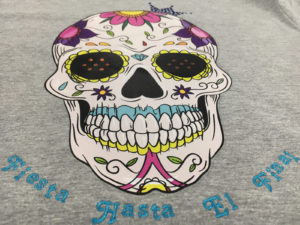
Printing and embroidery have long been associated together, so the idea of combining these two methods in a single design isn’t a new one. However, despite its advantages, it has still yet to gain real traction in the garment decoration industry. John-Paul Burton, director of YES Ltd, reports.
For those who already own an existing embroidery business, self-weeding heat transfer printing systems can offer an easy way of creating new, unique applications at a relatively low cost.
In an industry that is growing at a rapid rate, being original isn’t just an option, it has become a requirement.
Why should you consider combining them?
To understand why you should be combining embroidery and printing, it’s essential to first accept that embroidery has its limitations.
Overall, embroidery requires a certain level of skill, especially for those who don’t want to use a digitiser. This can make creating great, quality designs rather difficult for inexperienced users. Even for those more experienced at digitising, there are design limitations that you can’t avoid. Extremely detailed designs including aspects like small, cursive texts, will almost never end up looking as good as you want them to. At the opposite end of the spectrum, large designs offer their own pitfalls such as the high stitch count and long run times which can set you back on other jobs.
So, here is where self-weeding heat transfer printing can really make a difference. Overall, adding heat transfer to your set-up won’t break the bank. Available from YES Ltd, TheMagicTouch, Amaya and more, the price for an A4 system can start at around £1,500 to £2,000, giving it a relatively low cost compared to other garment printing methods.
In terms of usability, the whole process of heat transfer printing is rather simple. Compared to other printing methods, the learning curve isn’t as steep, so you can begin selling garments and earning a profit almost immediately. Most importantly though, is the ability to print high-quality, detailed graphics that can produce, in some cases, a much better appearance than most embroidery.
Heat transfer printing, therefore, offers an effective way to make up for some of the limitations associated with embroidery. The more complicated portions of an embroidery design can be replaced with printing along with detailed sections which will make it easier to create a great overall design without much fuss. Large designs can be printed first before using embroidery for smaller, stylistic purposes within the graphic.
The process of combining methods
The general process of combining these methods is relatively simple. The first step is to understand what you want the overall outcome to be and decide which portions of the design will work best being printed or embroidered. The printed aspects of your design will need to be completed first, making sure to leave out the areas that you want to embroider. Then, all that’s left is to digitise and embroider the rest of the design.
In practice, this is where some people may run into issues because the alignment of the print and embroidery will need to be perfect. This issue can easily be solved with the use of alignment tools. But if you don’t want to purchase additional embroidery accessories, you can simply create designs where alignment doesn’t have as much importance, such as by adding embroidered text to the bottom of a design. While this is not as impressive, it can still make an impact.
What this means for your business
The advantages of combining printing and embroidery come down to two major factors: profit and competition.
By swapping out a portion of embroidery when creating large designs, you can dramatically reduce your running time. This allows you to move on to the next job quicker, increasing your productivity by allowing you to do more in less time than it would have taken.
Mixing decoration techniques can also give customers the impression that they’re getting more from their purchase which will allow you to increase some of your prices.
Lastly, combining printing and embroidery offers a way of setting your business apart from your competition. Low entry barriers have made it easier than ever for people to get into the garment decoration business. As more people become involved, the competition grows and your potential market share drops. As this happens, doing the same as everyone else isn’t good enough. You need to be able to offer something unique to your customers, something that will put your company above the rest.
Creating unique and interesting designs that combine both embroidery and printing could be just the push that your company needs.
 Printwear & Promotion The Total Promotional Package
Printwear & Promotion The Total Promotional Package




